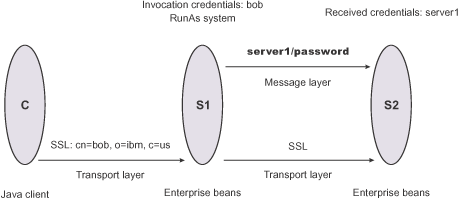Example 3: Configuring client certificate authentication and RunAs system
This example presents a pure Java client, C, accessing a secure enterprise bean on S1.

C authenticates to S1 using SSL client certificates. S1 maps the common name of the distinguished name (DN) in the certificate to a user in the local registry. The user in this case is bob. The enterprise bean code on S1 accesses another enterprise bean on S2. Because the RunAs mode is system, the invocation credential is set as server1 for any outbound requests.
Tasks
- Configure client C for transport layer authentication (SSL
client certificates).
- Point the client to the sas.client.props file.
(Dist) Use the com.ibm.CORBA.ConfigURL=file:/C:/was/properties/sas.client.props property. All further configuration involves setting properties within this file.
(iSeries) Use the com.ibm.CORBA.ConfigURL=file:/ profile_root /properties/sas.client.props property. The profile_root variable is the specific profile that we are working with. All further configuration involves setting properties within this file.
- Enable SSL.
In this case, SSL is supported but not required: com.ibm.CSI.performTransportAssocSSLTLSSupported=true, com.ibm.CSI.performTransportAssocSSLTLSRequired=false
- Disable client authentication at the message layer. com.ibm.CSI.performClientAuthenticationRequired=false, com.ibm.CSI.performClientAuthenticationSupported=false
- Enable client authentication at the transport layer. It is supported, but not required. com.ibm.CSI.performTLClientAuthenticationRequired=false, com.ibm.CSI.performTLClientAuthenticationSupported=true
- Point the client to the sas.client.props file.
- Configure the S1 server. In the administrative console, S1 is configured for incoming connections to support SSL with client certificate authentication. The S1 server is configured
for outgoing requests to support message layer client authentication.
- Configure S1 for incoming connections.
- Disable identity assertion.
- Disable user ID and password authentication.
- Enable SSL.
- Enable SSL client certificate authentication.
- Configure S1 for outgoing connections.
- Disable identity assertion.
- Disable user ID and password authentication.
- Enable SSL.
- Enable SSL client certificate authentication.
- Configure S1 for incoming connections.
- Configure the S2 server.
In the administrative console, the S2 server is configured for incoming requests to support message layer authentication over SSL. Configuration for outgoing requests is not relevant for this scenario.
- Disable identity assertion.
- Enable user ID and password authentication.
- Enable SSL.
- Disable SSL client authentication.